This week we’re sharing all the best things to see and do in the classical city of Kyoto, Japan. We share tips for visiting Kyoto, where to stay in Kyoto, how to get around, and the top attractions. Plus we share why Kyoto is the perfect hub to also visit Nara and Hiroshima.
Where to Stay in Kyoto
- DoubleTree by Hilton Kyoto Station– It is in a great location right by Kyoto station and a 7/11 with GREAT food options!
- Kyoto Hot Spring Hatoya Zuihokaku Hotel
- Daiwa Roynet Hotel Kyoto Ekimae
Things to Do in Kyoto
- Arashiyama bamboo grove
- Arashiyama monkey park
- Kinkakuji temple aka “Temple of the golden pavilion” buddhist temple
- One way path to walk around and see the sights
- Nishiki market
- Walk the streets of Gion, aka the Geisha district
- Fushimi Inari-taisha
- Other things to see in Kyoto:
- Saiho-ji- one of Kyoto’s best known gardens, specifically it’s moss garden and moss temple
- Imperial Palace & gardens
- Plenty of other temples
- Book a recommended activity or experience
Grab a copy of our 2 week Japan Itinerary and listen to our episode on Tokyo.
Find a great flight deal to Japan by signing up for Thrifty Traveler Premium and watching the daily flight deals (points & cash) that are emailed directly to you! Use our promo code TS10 to get $10 off your first year subscription.
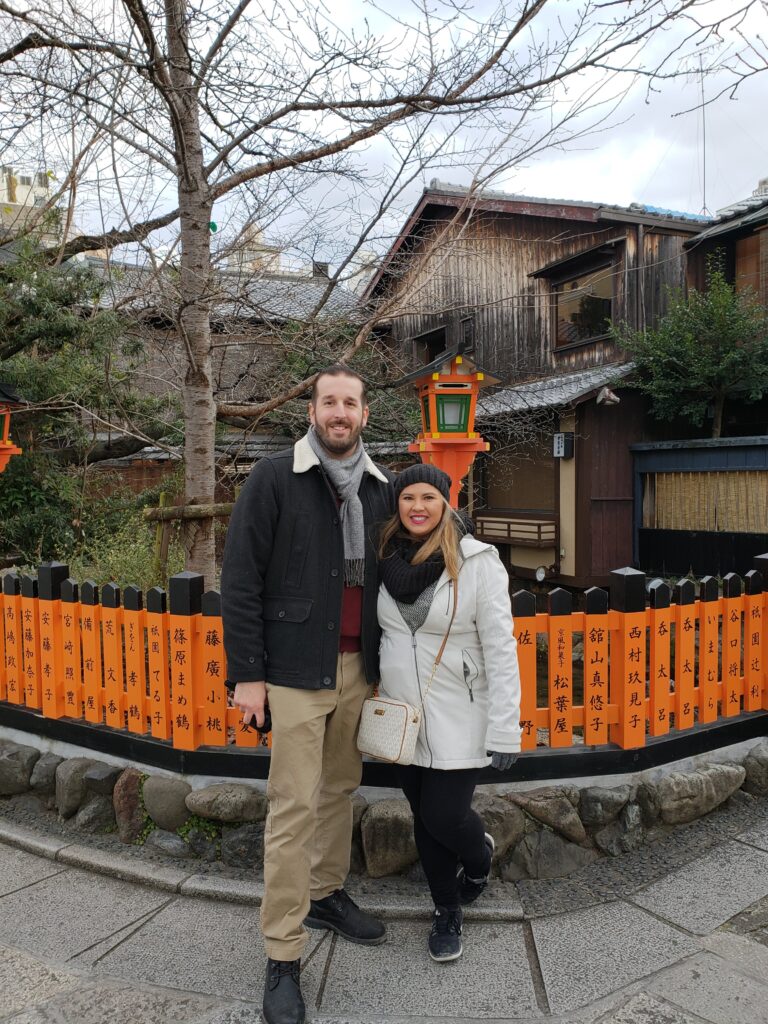
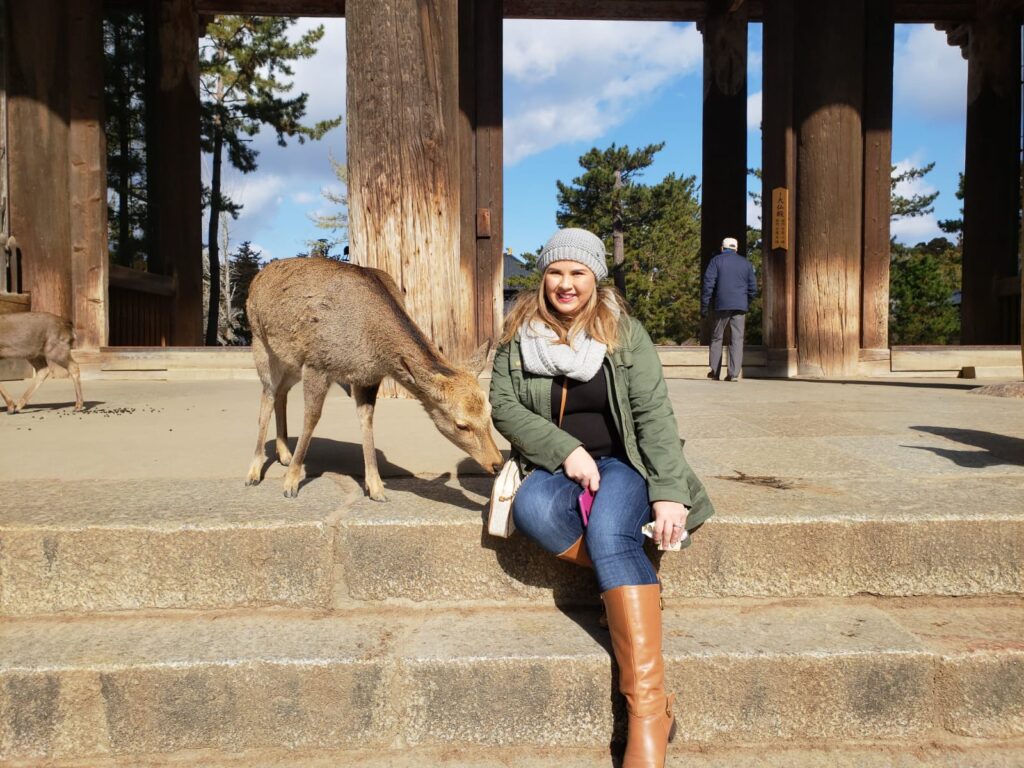
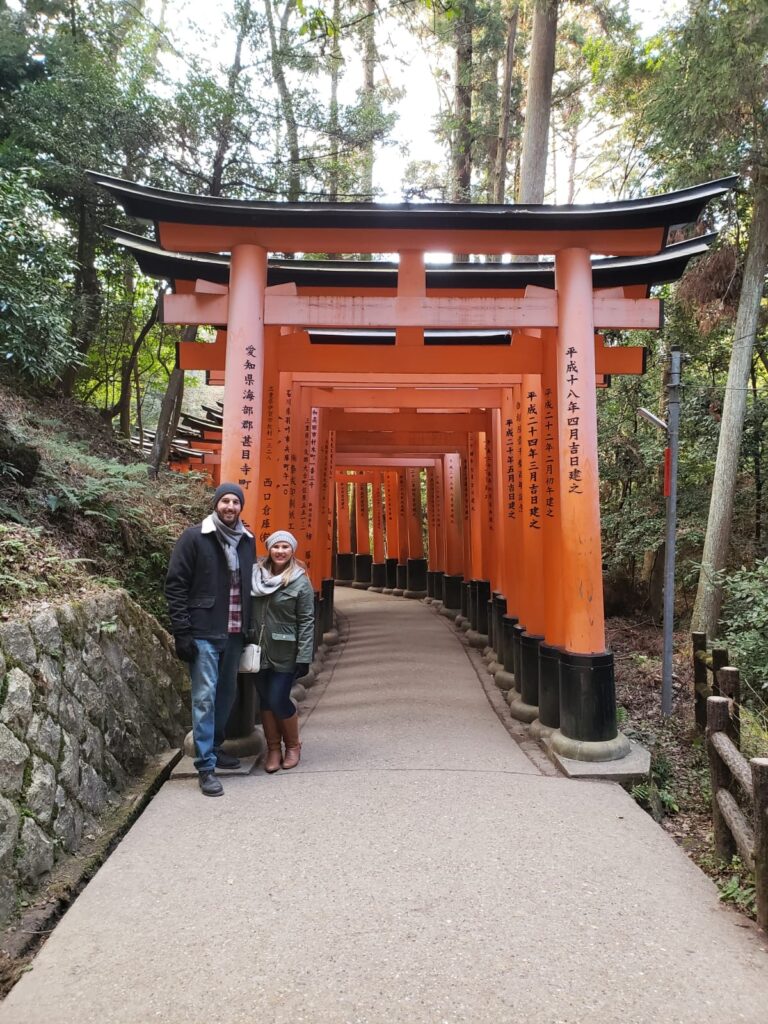
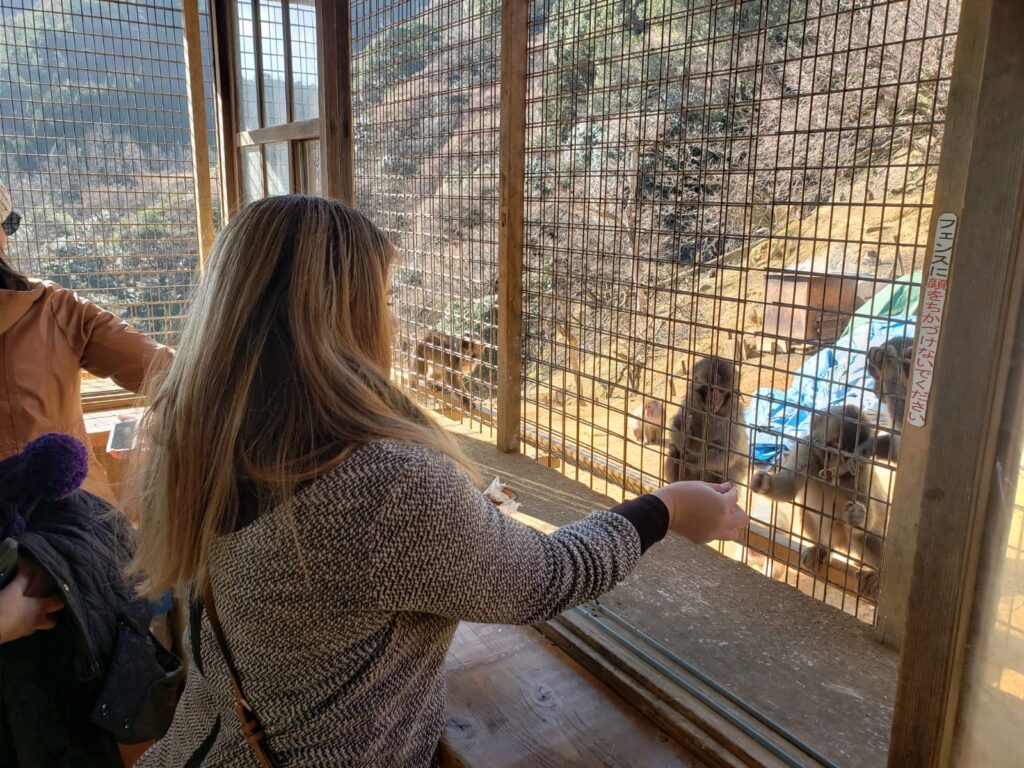
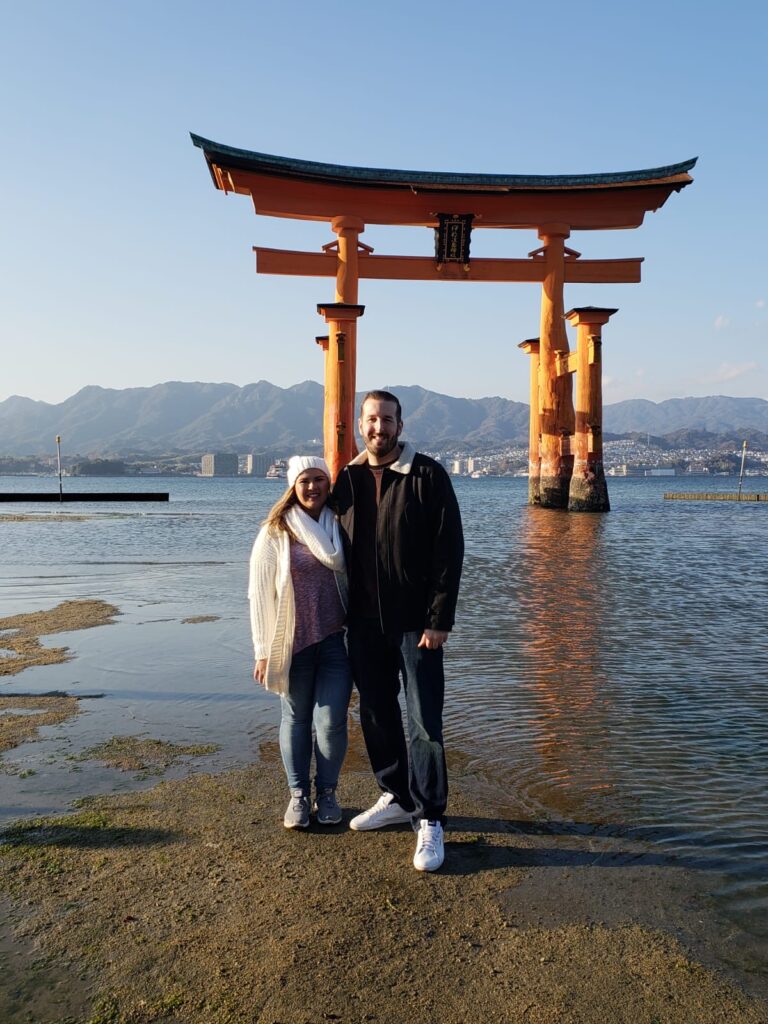
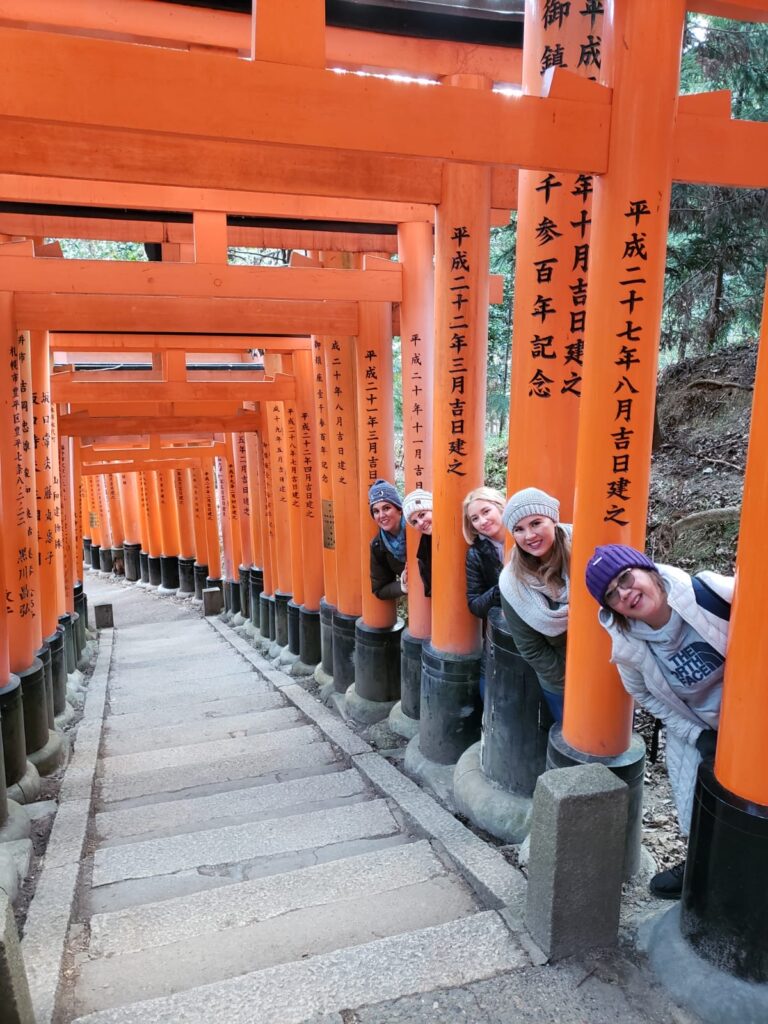
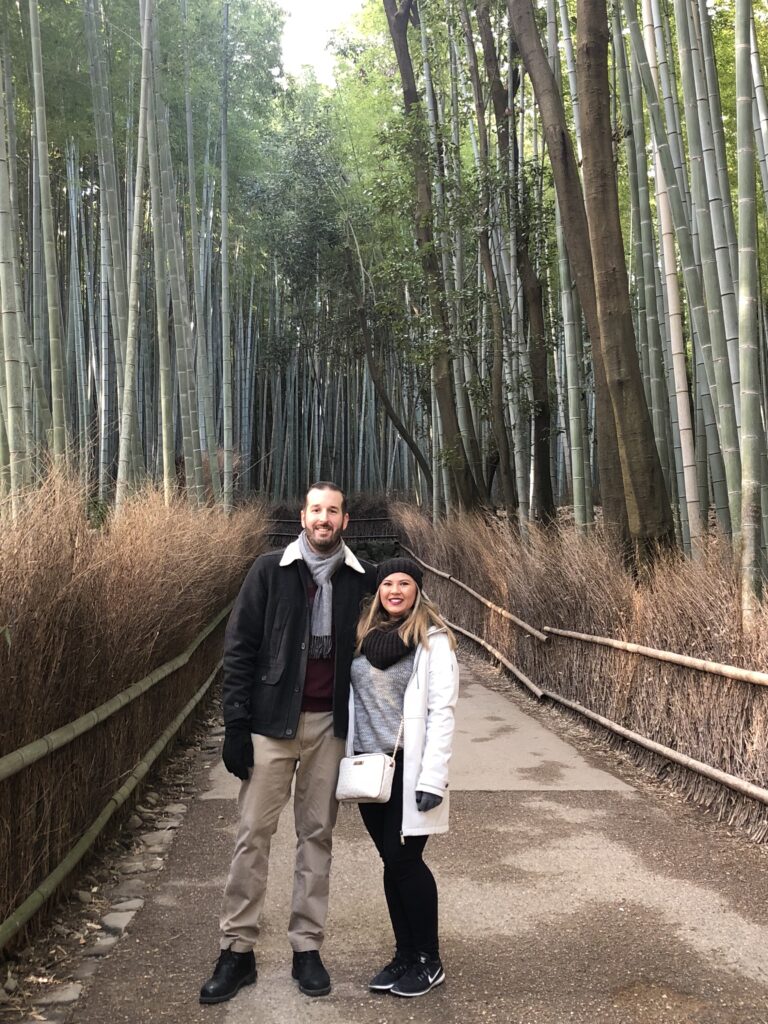
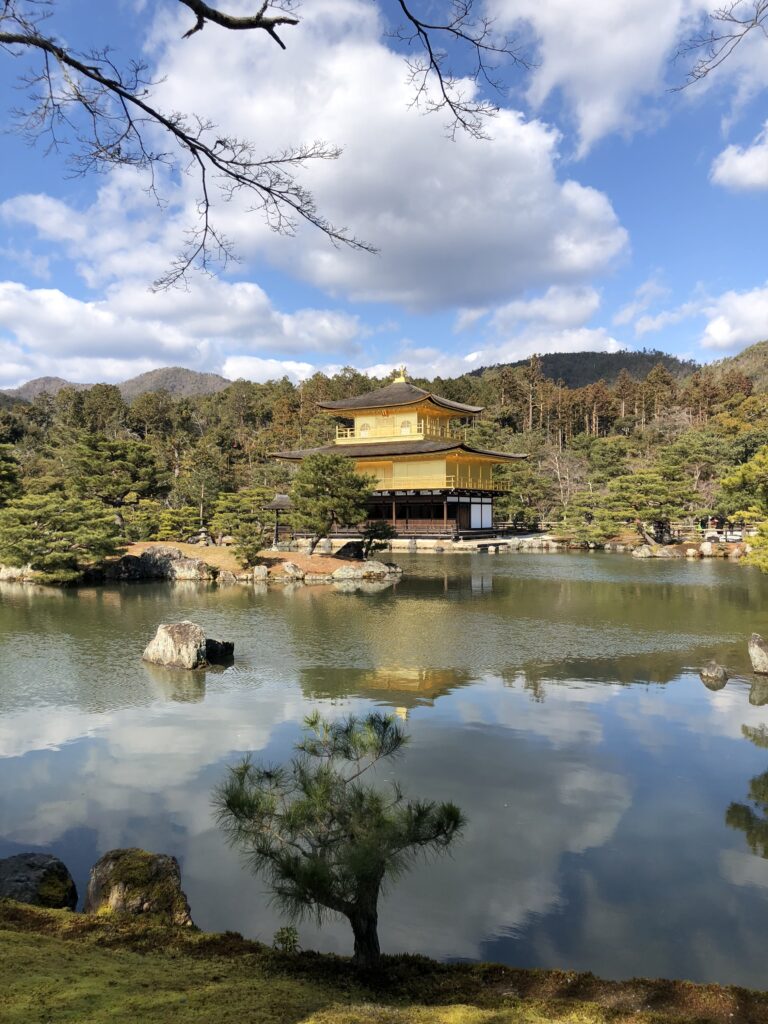
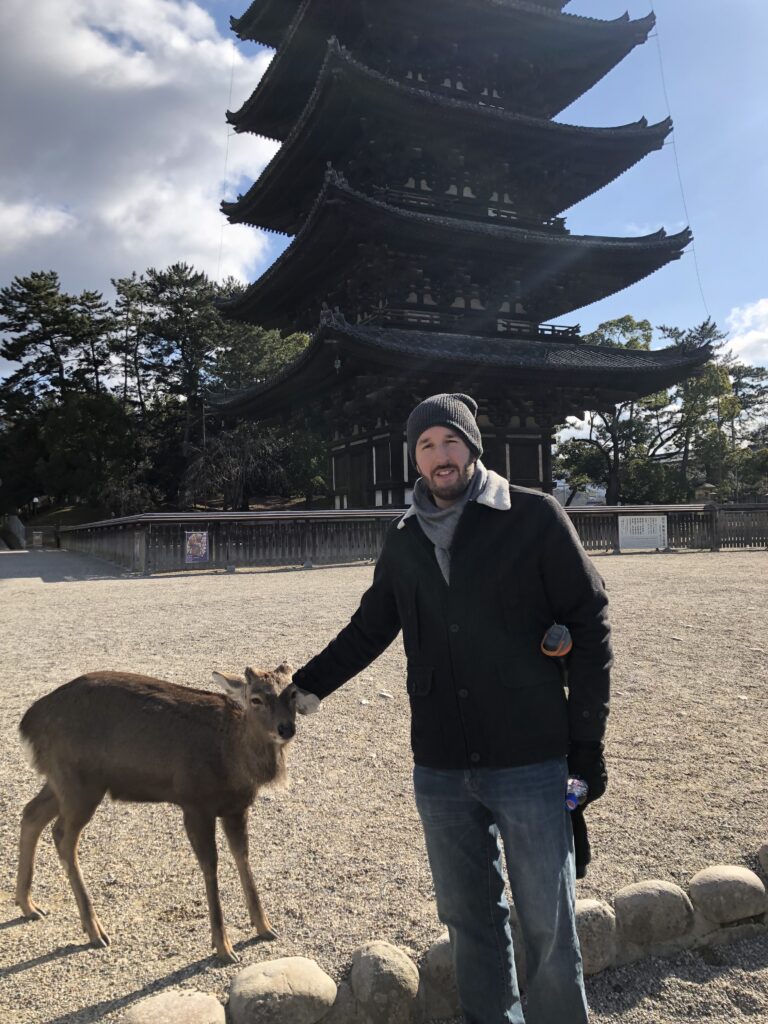
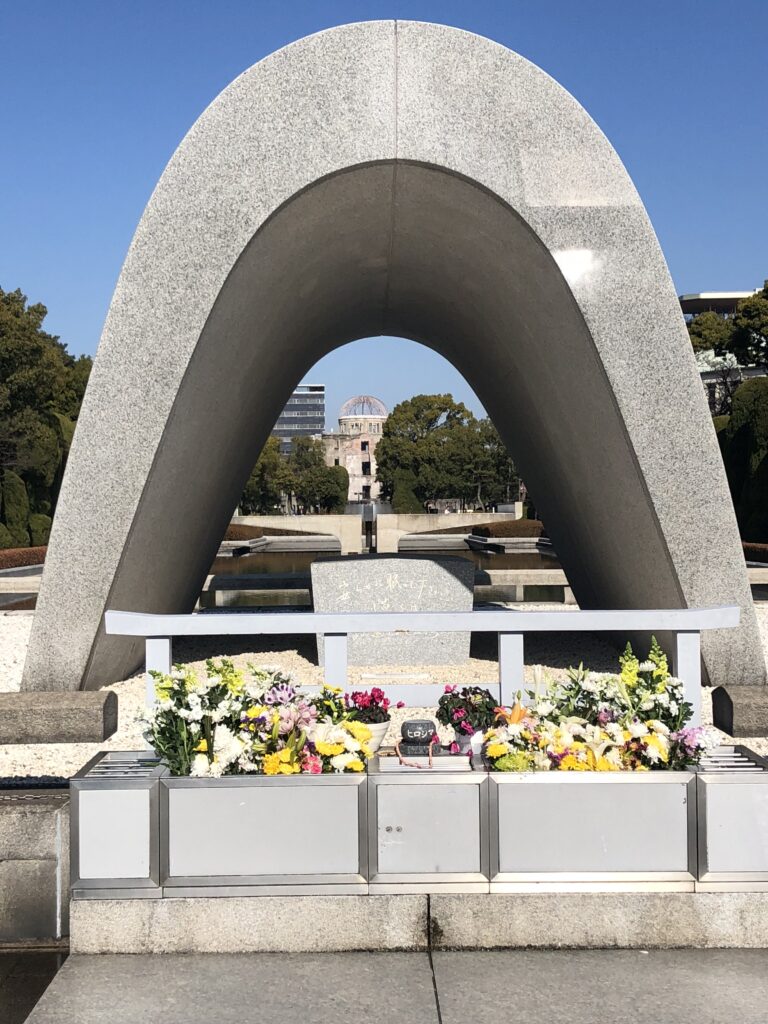
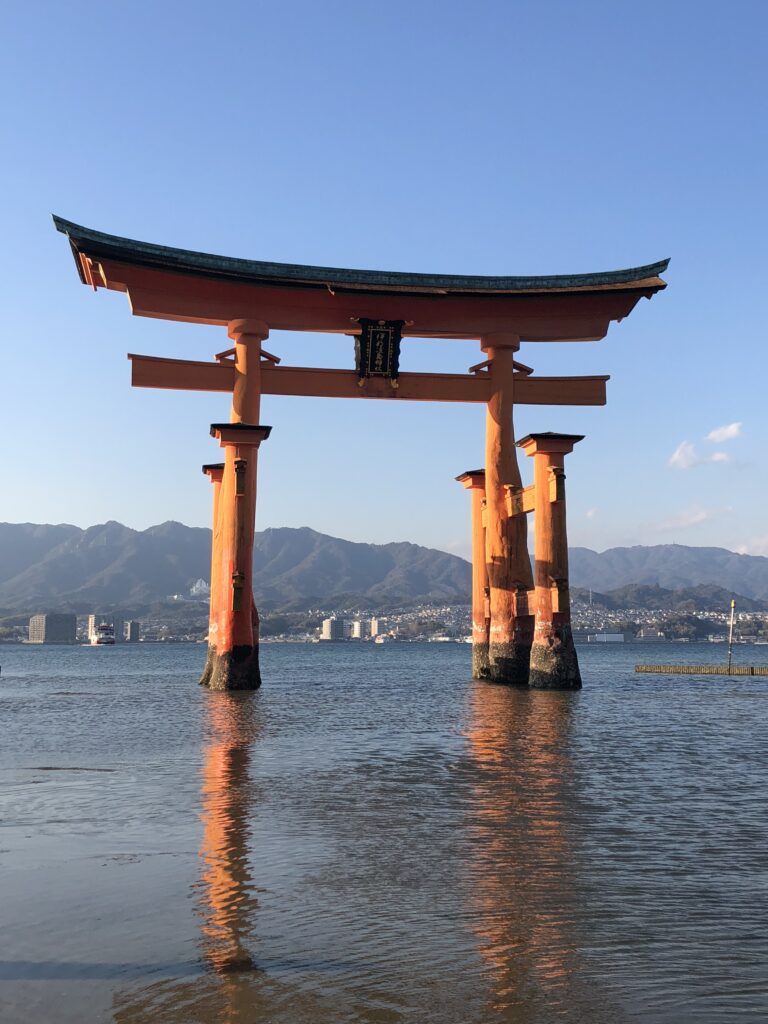
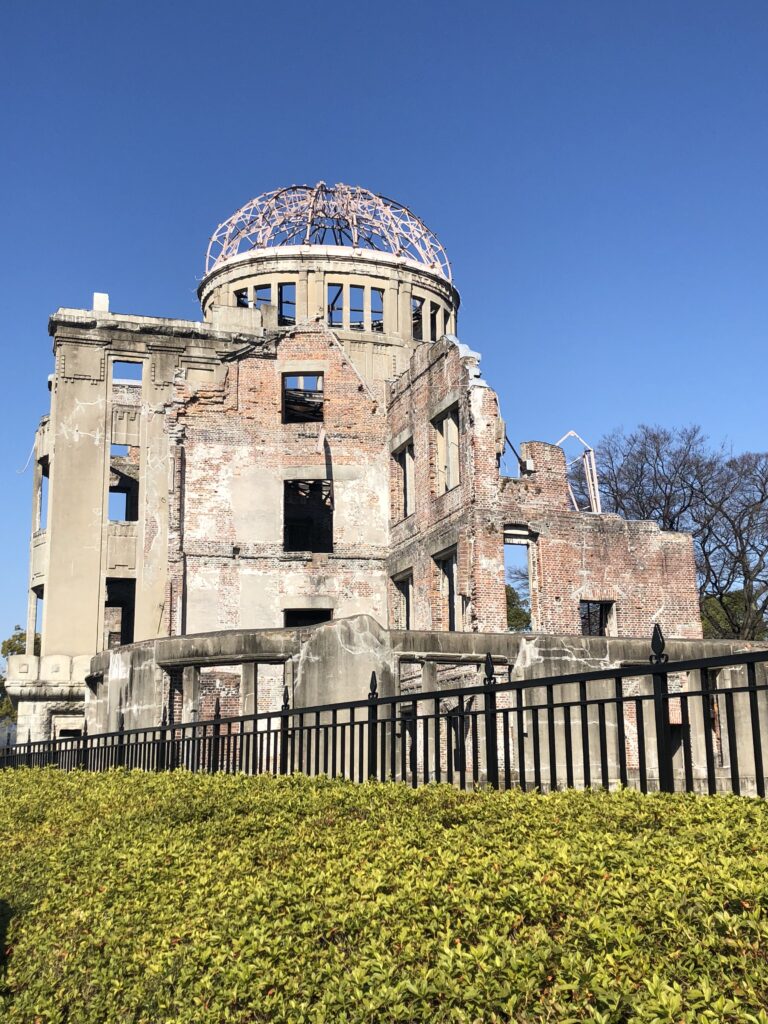
Kyoto – Episode Transcript
0:35
Konichiwa, fellow travelers!
Welcome to this week’s episode of the Travel Squad Podcast.
Today we’re taking you to Kyoto, a classical city in Japan.
0:52
We love Kyoto so much and we spent several days exploring Kyoto and the surrounding areas.
I really love that Japan has such a great public transportation system because we used it so much for inside and outside of the city of Kyoto.
We visited Kyoto several years back when we went on our adventures around Japan, and even though we have a previous episode where we talked about our time in Japan, this is going to be all about Kyoto.
1:18
We constantly continue to receive emails and DMS with your questions about Kyoto, and with Japan being a hot travel destination right now due to the dollar being really strong against the Japanese yen, we really wanted to bring you guys this episode to help with those Japan travel plans.
1:34
We have a couple episodes already on Japan on this epic trip that you all took.
Out of all the places that you 2 went, Kyoto seems to be the one that you talk about the most.
Why is it so amazing?
Well, Kyoto is simply amazing because it’s one of the few places and large cities in Japan that you can go to that doesn’t feel like a mega metropolis.
1:57
There really are no skyscrapers there.
I mean, there’s one tall building, and I’ll get to that in a little bit of a second here to describe what it is.
But for the most part, everything in Kyoto is not a high rise.
It’s classical.
It’s filled with brines and temples, and you really get that historic Japanese architecture that you would equate with Japan here in Kyoto.
2:21
And the reason for that, as a matter of fact, real quick little history lesson for everybody here is it’s the only, or if not the only one of very few major cities in Japan that was saved from bombing during World War 20.
Yeah.
And so it has a lot of its classic architectural buildings still in existence because they didn’t really bomb it.
2:43
And even though they didn’t vomit during the original campaign, this was on the docket as a potential for the dropping of the nuclear bomb.
But at the time, the US Secretary of War, which that was the name of the position, now it’s called Secretary of Defense Henry Stimson.
2:59
He persuaded President Truman to take Kyoto off the list.
Now, there’s a rumor out there that he had his honeymoon and Kyoto fell in love with it.
That’s why he didn’t want it to be bombed.
That’s not actually true.
He’s been to Kyoto and liked it, but he wasn’t on his honeymoon.
But he’s really the person that saved Kyoto from being absolutely destroyed because this is where they wanted to drop the nuclear ball.
3:21
Wow that is cool that it it got saved.
It makes me a little bit sad thinking about all of the other parts of Japan that what they could have been.
Yeah, I was going to say, one of the reasons why I love Kyoto so much is probably because we spent a lot of time there.
Kyoto was a great hub.
It’s a great city and a great hub to visit other areas and the surrounding cities.
3:39
You can easily get to Nara in like 45 minutes and some other places.
So we spent the most amount of time in Kyoto behind Tokyo, of course, but Tokyo we focused a lot on the Disney parks.
So I feel like we really got to feel for Japan while we were in Kyoto.
And Kyoto served as the capital of Japan from the year 794 all the way up until 1868.
4:00
So that’s just shy of 1100 years of history in this one city.
So again, when we’re talking about the classic architecture, the temples, the shrines, and we mentioned this on our previous Japan episode, but we’ll go ahead and remind everybody, if you don’t know, a temple is a Buddhist thing.
4:17
A shrine is a Shinto building, and Shinto is the indigenous religion of Japan, whereas temples are for Buddhists.
Very interesting.
And I know this is not a metropolis city, or at least it doesn’t feel like it.
There’s no skyscrapers there, but there’s still a lot of people there, right?
4:34
1.4 million people.
So they again, that’s where it gets the uniqueness.
It’s a very large city and when you think of Japan, you think of these large metropolises such as like Tokyo, Osaka, skyscrapers, big shining neon lights, signs, etcetera.
4:49
None of that really to be found in Kyoto.
And I kind of alluded to this earlier.
I feel like this is a good time to get to it.
I mentioned that there were snow skyscrapers.
Well, that’s not true.
There’s actually one and that’s Kyoto Tower.
And with its antenna, it’s 430 feet tall, which is pretty tall.
5:08
But in comparison to the other buildings, there’s nothing anywhere near that height.
And even when this was built in the 1960s, it caused such controversy because everyone in Kyoto thought this is way too modern, it’s not going to fit the aesthetic of the city.
5:23
And people were throwing a hissy fit.
The government for whatever reason, built it.
But that’s not to say that there’s not modern buildings and buildings that aren’t maybe four or five stories tall, because of course there is.
But you’re not going to find that mega dense metropolis here in Kyoto.
5:40
Nice, calm, quaint.
All right, I know you 2 have them, so let’s go in hard with the tips for Kyoto.
So Kyoto is only a two hour and 20 minute bullet train ride from Tokyo.
So if you are hard on wanting to visit Tokyo, this is an easy bullet train ride away from Tokyo.
5:59
So we’ll start there.
Speaking of taking the bullet train, if you get to Kyoto this way, which if you’re anywhere else in Japan you absolutely should, I wouldn’t even recommend at all flying from one city to the next.
Take the train.
It’s an experience in and of itself, but to that point, day at a hotel near Kyoto train station.
6:18
Kyoto train station is amazing.
It’s a central hub.
You can take the bullet trains, more regional non bullet trains for the day trips or half day trips that we’re going to talk about coming up here on things to do utilizing Kyoto as a hub, but with that same theme.
6:34
Also looking to bind the Jr.
Rail Pass in advance.
Jr. stands for Japanese Rail.
This is only available to foreign tourists, but you can get a substantial discount versus buying individual tickets.
You can buy it for a week, 14 days, 21 days in advance, which pretty much gives you unlimited use on a lot, if not majority of the trains within Japan.
6:58
Yeah, the price has gone up with the Jr.
Rail Pass in recent years.
On their website, though, you can put in where you plan to go and you can actually see if it’s worth buying the pass or if it’s worth to buy individually depending on what you have planned out in Kyoto.
So just take that into consideration.
7:13
Some of the local train lines allow you to use the Jr.
Rail Pass and on one of the day trips that we’re going to talk about from Kyoto, we used the Jr.
Rail Pass for a ferry and save money that way as well.
Oh, so it goes beyond the train?
It does, yes.
7:29
Next tip would be to have some sort of cell phone service, more particularly for data.
So check with your local carrier that you have, see if you have any service internationally.
We say this all the time.
We love T-Mobile because they give you 5 gigabytes of data free per month on certain phone plans if you’re traveling internationally outside the United States.
7:51
But one thing that’s really unique about Japan is they have the capability of where they rent to you pocket Wi-fi’s.
So this will allow you to have data streamed to your phone.
That way you can get around, use it for Google Translate.
You have directions.
8:06
You’re going to want some sort of data service.
So just be sure to either get that pocket Wi-Fi or look into your local carrier and see what options they have for you on your home phone.
Do you purchase the pocket Wi-Fi in the airport or ahead of time, or how does that work?
We reserved ours online ahead of time and we picked it up in the airport when we arrived and but you can also have them delivered to your hotel or they have some pick up spots.
8:32
So it depends on where you’re renting from and who you’re renting from, but there’s a lot of different options to get them.
The Jr.
Rail Pass website actually has a link for you to order the pocket Wi-Fi, so if for whatever reason you happen to be flying direct into Kyoto, you can get it from the airport probably there or just when you’re booking your Jr.
8:50
Rail Pass.
If you already know what hotel you’re going to be at.
Again, they will have it already delivered to a lot of hotels so it’s very easy and convenient to get with lots of options.
Well, we’re kind of on the subject of hotels.
Do you want to mention not just for Kyoto, but just in Japan in general, Sometimes when you’re looking to book a room, sometimes it’ll say single room, which means like it’s literally one, like double bed or a twin bed.
9:16
Even.
So when you’re looking to book a hotel room, just be conscious of the bed type that you’re selecting because it’s not here in the US where it’s you’re getting a king size bed necessarily.
Did you and Jamal have any mishaps where you had to share a twin size bed?
9:33
We did not have any mishaps about having to share a twin size bed, but I think in one of the hotels it wasn’t in Kyoto, it was outside of Kyoto.
We had our own separate beds that were like twin or double sized so.
Yeah, ’cause there was no rooms available left with bed large enough for both of us, so we had to get like two single beds.
9:51
And that’s actually very common in Japan also.
A lot of the hotels though do provide robes and slippers.
It is a country where you should not be wearing your shoes in the room.
You take your shoes off at the entrance, you put on a robe and slipper for when you’re in the room and.
10:08
Are you also supposed to disrobe upon entering your room?
You know, I didn’t look into that, but I think that’s just the natural progression, right?
I guess it depends on who you’re entering the room with.
Hakim, we don’t know.
And while we’re talking about amenities, you know, Japan is a very clean culture.
10:25
They have the most amazing toilets I’ve ever sat on in public.
A lot of the times they’re heated, so you’re never sitting on a cold toilet seat.
And then of course, they have the bidets attached to them so they have the control, so you can control where the water is hitting the front, the back.
10:41
Poster Tosh, as we like to really say.
It gives you the option, and the water comes out hot and warm.
This is one of the things that we stress all the time when we’re talking about Japan, especially if people haven’t been, they don’t know toilet culture in Japan.
Amazing, amazing.
10:57
I-10 out of 10.
Yeah.
Even public restrooms are amazing.
Majority of them have the the days and I love it.
It’s probably one of my favorite things about Japan, believe it or not, but just know that those are there because if people don’t, sometimes there’s a learning curve to figure out all those button options that they have on the bidet.
11:16
So just kind of do your research before you go to figure it out because sometimes when it sprays the water, it can go on forever.
You have to actually hit the button for it to stop.
Some of them stop automatically.
So there’s a little bit of learning curve, but once you get the hang of it, it’s full blown luxury out.
11:32
There.
Well I know you 2 went when it was cold season.
My concern is if you’re there during warmer months, you might not want that warm toilet seat or the warm water are there.
Temperature options here.
You know, that’s a great question that when we go back during warmer times, we’ll have to let you know the answer.
11:49
I really don’t know that, Kim.
Great question.
Where did you 2 stay when you went to Kyoto?
So like Jamal had mentioned in the tips, we wanted to stay by Kyoto Station.
And I just want to mention Kyoto Station is a vibe.
12:05
It’s like a mall, train station, hotel all in one building.
Hakasan.
I’m sure there is.
There might as well be one.
I wouldn’t doubt it.
I mean, everything that you can imagine is at the train station.
And it’s not even just in Kyoto, all over Japan, the train stations, I mean, they are a main transportation hub.
12:25
There’s always lots of amenities, things to do, restaurants like Brittany had mentioned.
But we really felt when we were in Kyoto, Kyoto Station was the nicest and kind of had a lot more things than we saw even when we were in Tokyo.
For me, train stations are hectic, they’re crazy, I don’t like them, they’re hard to understand.
12:44
There’s too much going on.
Thinking back to the one in London, I try to avoid them at all costs.
Is it more orderly?
Because I know you’ve said the subway lines are very orderly in Japan.
I felt like it was like going to a mall really.
I didn’t feel like it was super hectic or anything.
13:00
That was our experience when we went.
But I get your son to meet Kim where like you don’t want to go to a lot of train stations.
Like you people are there rushing to go somewhere.
But I feel like this is just more than that.
And there’s different layers to the train station where like the trains actually leave and then where the shops in the mall and restaurants are.
13:21
So I feel like it’s a little bit more laid back.
But you were asking where we stayed.
We stayed at the Daiwa Royal Hotel Grande in Kyoto.
It was right around the corner.
It was a walkable distance with our luggage.
So that was one of the main reasons we picked it.
It was nice that they had really nice robes and slippers, and there was also an espresso machine in our room as well.
13:45
A great place to stay.
Also in Japan, 7 elevens are super popular.
Do you know much about the seven elevens in Japan?
Kim.
I’ve heard they have some gourmet food.
Options, lots of great food options.
They have cold drinks.
They even have hot drinks there and not the ones where we’re thinking like come out of machine that are like hot.
14:05
Like if you go into gas station and get a hot drink.
No, they have like think of a refrigerator, but instead of a refrigerator it’s a heater for drinks.
So you can go in and grab like a can or a bottle and it’s warmed.
Hot coffee, hot tea, anything like that.
14:22
So it has snacks, quick bites, sandwiches, sushi, ramen packets, everything at 7:11.
So we wanted a place that was nearest 711 and near the train station and this fit the bill.
Also, again, we were right by Kyoto Station, as we had mentioned.
14:38
I will say this, when you go to Kyoto, once you get settled into the hotel or maybe before you go to the hotel, if you happen to be staying a little bit further away, stop by the Kyoto Station Visitor Center.
It’s a great place for anybody to go.
14:54
You can buy your metro and bus cards there that will give you unlimited use for, you know, 244872 hours.
A lot of the workers, well, not a lot of the workers, all the workers in there speak a second language to help you with whatever language you do speak.
15:11
And they can give you maps, tell you, yes, you want to go here, this is what line you need to take or this is what bus you need to take, then transfer.
So if it’s been hard for you, or even if you were able to figure it out but just want that reconfirmation or just get a second piece of advice from somebody, go to the visitor center and have them just really fine tune that itinerary and travel route for you.
15:35
It’ll make your experience getting around Kyoto a lot simpler because in Kyoto there’s only two metro lines.
One runs north to South, one east to West, and that really leaves a lot of gaps in between.
Most of your stuff is going to be bus, so they can really help you out with those bus routes.
15:51
And when we were there, we used Google Maps for the public transportation setting, and that helped us get around Kyoto just fine.
So download those offline maps, right?
Yes, but more importantly too, beyond having the offline maps, make sure you have Wi-Fi or data so that you can use the public transport setting.
16:11
So that’s getting settled.
And once you get to your hotel, make your stop in Kyoto Station Visitor Center.
What are we going to do?
We hit the ground running the next day after we had gotten settled because we arrived via train kind of in the late afternoon, early evening.
16:27
We went to the Arashiyama Bamboo Grove.
If you Google Photos of Kyoto, I’m sure this will come up as one of the top photos.
And they are famous for their bamboo Groves that grow 50 to what, 7500 feet tall bamboo shoots?
16:43
Yeah, definitely one of those Instagrammable places.
I think it’s worth it if you want the picture.
It’s not the most amazing place, though, like I will say that.
But the farther in that you go, of course, the less people you’ll see, so you’ll get better shots with no one in them.
17:00
But honestly, we didn’t budget a lot of time for it and we just wanted to stop here real quick before we went to the Arashiyama Monkey Park.
This is something we were really excited about.
It’s only a half mile from the bamboo forest, but you do have to do a 20 to 30 minute steep hike up a mountain.
17:18
But once you get to the top, you can feed the monkeys, which are the Japanese macaque, you can feed them bananas and nuts that they have that you can buy.
And at the top you get a really beautiful view of Kyocho as well.
And I just want to say, I know we’re already on the Arashiyama Monkey Park.
17:34
I want to just back up a little bit to the Bamboo Grove and say one thing about it.
We highly recommend going first thing in the morning because one, less people will be there, but two, this is the furthest thing from city center, probably where you’re going to be leaving from till everything that you do later in the day.
17:53
You’re working your way back into city center and your hotel.
So this is on the outskirts and we’re are now working in.
But like you had mentioned, Brittany, the monkey park is only that half mile walk away.
Most of it is that little hike up the mountain to get to where they’re at.
But I loved our time when we were at Arashiyama Monkey Park.
18:11
They even have a monkey feeding.
Yes, you can for a few yen, buy food, feed them yourself, which is really fun.
But the workers will have like a mass feeding where they take buckets and they just, like throw it out.
And then you can watch all the monkeys descend and grab and hold and they’re not even eating as they’re picking it up.
18:29
They’re just like holding it, stacking it like squirrels with nuts in their mouth, except it’s not in their mouth.
It’s in their paws and hands.
And as soon as there’s nothing left, they’re just like running off and getting back up in the trees and eating and having their feast.
So this is a cool, fun experience and it gives you, since it’s at the top of the hill, a great panoramic view looking down onto the city of Kyoto.
18:49
Yes, it’s definitely worth the time and it’s not that expensive to do.
Another thing that we would recommend to do while you’re in Kyoto, this is on the top of my list, was to visit the Golden Pavilion.
It’s actually called the Kinka Kuji Temple.
19:04
It’s a Buddhist temple and it’s also a UNESCO World Heritage Site.
And this temple is really beautiful and pretty, again, Brittany mentioned.
It’s this Golden Temple and it’s sitting on the middle of a lake, so you can’t even really get to the temple.
19:20
You’re just looking at it isolated on the lake and it’s the one way walking path all the way around so you can get a view of it from every angle.
And it’s just surrounded by this beautiful greenery.
And then you have the lake.
It was built all the way back in the year 1397, but in the 1950s unfortunately a young 22 year old monk started a fire, burnt a little bit of it down and so they have rebuilt it.
19:47
So the full thing is not the original, but it’s still again a UNESCO World Heritage site and also has a claim to fame because it houses some of Buddha’s relics and if you aren’t familiar with that as it means it’s ashes.
When the original Buddha had passed away it was cremated.
20:04
His ashes spread amongst a lot of places.
And this temple here is said to house some of Buddhist relics.
And because it is a one way path, make sure you’re taking time getting the pictures that you want, the different viewpoints, because once you continue on, you can’t turn back around.
20:20
It’s a one way circle, so make sure you’re getting all of the pics you need as the opportunity presents itself.
This is a good time to mention that we do have a full two week itinerary for Japan available on our website travelsquadpodcast.com.
20:36
You can find that itinerary and all of the other ones, but if you’re going to Kyoto, I’d highly recommend downloading it.
It gives the full day-to-day morning, afternoon and night plan for what to do, where to go, bus routes to take, prices, everything, even restaurant recommendations.
20:53
Yeah, the Japan itinerary has been our #1 seller.
And again, like I had alluded to earlier in here, we constantly get DMS with questions asking about our time in Japan, other recommendations.
So we saw it fitting to again do this episode because lots of people are asking about Kyoto, but that itinerary is going to be a great resource for you.
21:14
Yeah, another one of my favorite things about Kyoto is the food, and Kyoto has a really amazing market.
It’s called the Nashiki Market, and they have over 100 shops that spans 5 blocks.
It’s Kyoto’s premier market.
21:30
There’s fresh seafood, seafood vendors, produce shop selling cutlery and cookware.
It dates back to several centuries.
Shop owners have been running them for generations and generations within their family.
OK.
But big question for you.
It’s centuries old.
21:46
How clean is it?
OK.
Kim, this is a great question because we got sick out of market previously in another country.
We ate a lot here and none of us got sick.
If Japan is one thing other than amazing, it’s clean and you need not worry about it.
22:03
Yes, it’s centuries old, but the buildings and the stands are really nice, well maintained.
It’s actually a covered market also.
So they have like built up awnings that cover the buildings that the stalls and shops are sitting in front of the very, very clean.
22:19
And it’s not like the market that we were in in the other country.
We won’t allude to it.
Just go listen to any of our episodes.
You’ll figure it out of which one we’re talking about right here, but the Nashiki market might be one of my favorite things that we did when we were in all of Japan, not even just in Kyoto.
22:36
This was my favorite market.
The food here was so good.
We got a lot of souvenirs.
So you can really come and just decide to eat here and you really need to bring cash.
One thing that we didn’t mention in the tips, but it’s very true is Japan is a cash based society, especially in the markets.
22:55
So come cash in hand because most of these vendors that are at least selling the food aren’t going to be taking credit card.
There’s a lot of samples that you can have while you walk around the market, so definitely sample it up.
One of the things that I got was an octopus pop, which was like a baby octopus that was like, I don’t know, almost like candied, but there was a quail egg that was hard boiled on the inside.
23:17
Very unique.
I know Kim, you’re probably like what the hell, but I try.
I had to try it.
It was good.
And there was also like on a side street, there was a vending machine that was selling Peach flavored beer and I have not forgotten about it.
23:33
I still think about that Peach flavored beer to this day.
Was that good, huh?
It was so.
Good fruit flavored beer fan, but I remember taking a sip and thinking, my goodness, that is delicious.
Another thing that Japan’s really well known for is vending machine culture.
23:49
And yeah, don’t not look into the vending machines either here when you’re at the market because you’ll find a lot of hidden gems and unique things that are really, really good.
One of the most popular things to do in Kyoto also is walk the streets of Guyon, which is the geisha district.
24:04
If Japan’s known for a lot of things, geisha is one of them, and Kyoto is home to the geishas.
Do you see geishas freely walking the streets in this area?
We didn’t see any freely walking the street.
We did see some people dressed like geishas, but they were obviously tourists.
24:21
But we I would love to actually do a traditional tea house and have that geisha.
Experience.
I do remember looking into an experience like that when I was considering joining you on this trip, and I do recall you.
Brittany turning it down.
24:36
I know, I know.
And we’re actually going to be going to Japan very briefly while we’re in that part of the world.
And Kasha, who is going with us, made it a point that we are going to a tea ceremony.
Oh, so when Kasha wants it, Kasha gets it, but not Kim?
24:55
OK, I see.
I see What’s going on here.
No.
We’ve done to one too many regular high tea ceremonies with you, Kim, so this one was kind of like nixed.
From I don’t think it was that I didn’t want to go to the tea ceremony.
You wanted to dress up like a geisha and I did not want to dress up like a geisha.
Well, how do you do a traditional tea ceremony at a geisha house without dressing up and doing the whole 9 yards?
25:16
You allow the geisha to fulfill that portion and you just be the guest, no?
I’m going to talk to Kasha.
Well, we’ll see how that one plays out, but nevertheless, this is a very popular district To go to your question that you asked earlier when we were talking about the Geisha district here in Guillen and if we saw any walking around, we did not, but some do.
25:38
And very recently, I saw a video circulating here on social media of a foreign tourist in Kyoto getting in front of a geisha, like a real geisha that was walking the streets trying to take a photo.
You can tell she clearly didn’t want to have photo to be taken politely, kind of turned away, continued walking, tried to cover her face best she could with her fan, a little thing she had.
26:00
And this lady kept following her and following her and get in front and trying to take photos.
This this lady is getting ragged on on social media and rightfully so.
So just be respectful when you’re there.
This is something that’s part of their tradition.
And yes, you can take, you know, photos, but it’s not something to be gawked at and get in front of their face.
26:16
So just don’t do that and don’t be like that boomer lady that was taking those photos that was getting blasted on social media.
Yeah, it’s actually gotten so bad recently that this area is actually starting to ban tourists from entering some of the private streets because the tourist problem is so bad.
26:34
So there’s been a lot of tourists misbehaving.
So hopefully you can still explore this area a little bit, but just be sure to be polite and respectful of this area.
So another thing that we did in Kyoto, which is a must do is to go to the Fushimi and Nari Tashi, the shrine.
26:53
If you saw an Instagram photo of it or a Google photo of it, you’ll know it because it is the shrine that has like 10,000 of the Torry gates all lined up.
So you just see Torry gate out of Torry Bait gate.
The shrine sits at the base of it mountain and there’s a lot of smaller shrines as you go up the mountain.
27:11
The farther up the mountain you go, the less people you’ll have, so it’ll feel less touristy and more authentic, and you’ll be able to get better pictures.
Yeah.
I mean, I guess that’s a general tip and rule of thumb for anything.
I mean, if you’re at a tourist destination and you’re either going uphill or walking further away from the entrance, those are really going to be your best spots for photos because there’s going to be less people.
27:34
You could get better opportunities, see things that most people aren’t really seeing because they don’t venture that far.
But the Tory gates that Brittany had mentioned, if you’re unfamiliar with what those are, those are the very famous, like, Japanese gates that almost look like the mathematical symbol of π right?
27:51
That’s what they look like.
And there’s literally 10,000 of them at this shrine, all lined U.
And then you’re just walking under a Tory gate after Tory gate with its bright vibrant orange color.
It’s just so beautiful and unique.
Yeah, it is a one way path and so there are turn around points so you don’t have to go all the way up the mountain, but just make sure you’re looking at the map because if you pass a turn around point you could be going to the top potentially and you may not want to go all the way to the top.
28:20
I hear it takes a few hours to get up there.
We didn’t go all of the way because we kind of did this at the end of the day, but we had plenty of opportunities to really enjoy these Torrey gates, and the way down is just as beautiful as the way up.
I am surprised to hear that you wouldn’t go all the way up.
28:38
It was after a really long day.
I think we had taken a ferry earlier in the day, so it was kind of a time constraint as well.
But nevertheless it was still a great time.
It’s a must do stop and I believe it’s free, so must do stop.
28:53
You have to go there.
Great pictures you’re going to get.
I’ve seen the pictures but you can’t get it all in one shot so I didn’t know that they were hundreds of gates.
Not even hundreds, Thousands.
Kim.
Oh wow. 10,000.
That’s amazing and the pictures do look beautiful.
29:09
Tell them about the perfect photo to get if you’re with a group of people.
Oh, that’s funny.
Kind of.
So we have a picture where like, so all of the Torre Gates are lined up, but if you’re in a group of people, you can kind of like peek behind the Torre Gates and each person can be behind its own gate, I guess.
29:31
And you just kind of like peek out for the picture and then you get the path down the middle and that is the perfect shot.
And it’s also hard to articulate what it is that this looks like when there’s literally hundreds lined up in a row, thousands collectively.
So just Google Foshimi and Nari so you can see what we’re talking about and just grasp the idea and concept that we’re trying to relay.
29:53
I mean, it’s absolutely breathtaking and beautiful.
It’s surrounded by nature, so you have tall trees and bamboo growing all around you.
So it’s this real serene, unique place that is just absolutely a must do when you’re in Kyoto.
Those were the main highlights that we saw in Kyoto, but there’s a lot of different things that Kyoto offers.
30:13
There’s plenty of temples, the imperial palace and gardens.
And then Kyoto has another garden that is called the Sai Hoshi Garden, and it’s specifically known as like a Moss garden and Moss temple.
It’s supposed to be really beautiful.
Unfortunately, we didn’t get to visit that, but if you’re in the area, definitely check those things off.
30:32
When we go back to Kyoto, we’re definitely visiting them.
Disclaimer, if we have mispronounced anything in this episode, don’t e-mail us about it.
And 2nd for question for you 2 before we go on to some of the other stuff you did using Kyoto as a hub.
If you were only doing Kyoto and you weren’t doing any day trips or any other nearby destinations, is one day enough?
30:53
1 1/2 two days.
What would you say?
I would honestly say two days is what you would need if you’re not going on any day trips because you don’t want everything to be too rushed.
There’s lots of good food.
You will want to go back to the market a second time, try different things that you couldn’t eat the first time because you got so full.
31:12
And Kyoto is a place where you want to take your time because everybody else is really taking their time and at leisure.
And that’s just the aesthetic and pace of the city.
Did you know, Kim, that in Japan in general, you are not?
It’s like look down upon if you eat while you’re walking.
31:30
I think I have heard that before, and I do think it’s maybe universal, although not quite as practiced here in the USI mean, if I saw someone eating and walking, I’d be like, all right, where are you going?
Where do you have to be?
But yeah, like there, if you’re, if you’re getting a bite to eat, like you are sitting down to get a bite to eat or you’re staying in that restaurant to to eat it, you’re not going on the streets to like drink coffee or.
31:55
Oh, so it’s like that extreme, Like you wouldn’t even go outside and sit on a bench and eat it?
We didn’t see anyone really doing that.
It’s.
But I think you can.
It’s just you’re not supposed to eat and walk or eat on the metro or do all this type of stuff.
You’re really supposed to enjoy your meal.
32:12
So if you get something from like a food cart and find a bench and sit, I mean, that’s totally a OK.
But yeah, you’re not really supposed to be walking or moving around with it.
But like you mentioned, Kim, we did use Kyoto as a hub.
So we did visit some close nearby cities outside of Kyoto.
32:30
One of my favorite places that we visited was Nara.
Nora is known for the Sica deer that are there.
You can pet the deer, you could feed the deer.
They sell deer crackers from the vendors and the deer will eat anything you have in your hands.
32:46
So like a deer was eating my map.
Yeah, we were taking photos and Brittany was petting a deer.
Then another deer came from over her shoulder, bit the map out of her hand, ate like half of it.
And so these deer are really acclimated to human presence, right?
They’re obviously wild deer, but a lot of Nara, which Nara also used to be a capital of Japan historically.
33:09
So again, lots of temples, shrines, also another UNESCO World Heritage site.
But they’ve made their way from nature kind of into the central parks and shrines where a lot of tourists are.
They’re just really used to being around them.
So you will find even vendors that are selling those deer crackers, but again if you have your own food or even paper, they will try to munch it out of your hands.
33:32
So just be mindful as they get close to you.
But otherwise they are friendly.
Except for the one deer that head butted Britney right in the ass one time.
You remember that, right?
Yeah, I mean, how could I figure?
Forget I went flying in the air and.
She was feeding another deer and had her back turned and then another one came from behind trying to rush in and bumped her and then she just got knocked out.
33:55
I really wish I had my camera.
We’re rolling for that because that would have been great.
But that memory lives in my head, right for me, and I’ve loved it.
Did Jamal try the deer food?
How was it Jamal the.
Deer food tastes exactly like a fortune cookie.
I mean, they’re just selling cookies that they’re saying is deer food so that that’s what the vendors are selling.
34:12
You could buy it for not very expensive at all.
I think they’re not selling it more than the equivalent of like one or $2.00.
So, but I had to try it.
I said, what are the deer going crazy for?
And it tasted like a fortune cookie.
And it just so happens that Jamal likes fortune cookies, too.
So don’t get too excited by the first year.
34:30
Like we were super excited.
Like, Oh my gosh, there’s deer.
There are so many as you go through Nara Park.
Nara Park is a huge park with temples and shrines.
Some of them are known as UNESCO World Heritage Sites.
So the you’re going to see plenty of deer.
34:46
If you bow to a deer, a deer might bow back to you.
And we also saw a deer respecting the crosswalks.
Can you believe it?
Oh my gosh, you’re so smart.
I’m just so shocked that you said the deer might bow to you.
I feel like every deer when you bowed, bowed back to you.
35:04
And yes, they really did mind the crosswalk.
They waited for it to go.
It’s like I’m telling you, they are acclimated to humans and that makes the experience so much more fun.
They’re truly wild animals, yet they are acclimated to the presence in the city that is around them.
35:20
You have the temples and shrines.
Nara was really my favorite day trip that we took outside of Kyoto.
And one of the most famous parts of Nara inside the park is a shrine called the Kasuga Tashi Shrine.
It’s Nara’s most celebrated shrine, and it’s really beautiful.
35:37
There are hundreds of bronze lanterns hanging from the building, and then there’s a whole bunch of stone lanterns lightning the pathway to approach the temple.
The lanterns are only lit two times per year during specific Lantern festivals, But a whole shrine as a whole is so beautiful.
So you it’s definitely one that you have to check out while you’re in the park.
35:55
And those Lantern festivals if you time your trip rider just happened to be there during that time is in early February and mid August.
So just kind of Google and see when those official dates would be if that happens to be around the time that you’re going.
Because I think that would be really awesome to see those all lit up.
36:11
Because even during the day when we were there, it was cool to see the lanterns.
I can imagine seeing them at night all lit up when they finally do those two times a year.
That’d be amazing.
Plan your trip around it.
Another day trip that we took from Kyoto was to Hiroshima.
36:27
We used our Jr. train pass to take a train to Hiroshima and we spent the day there.
What did we do, Jamal?
We did lots of things, and we’ve mentioned this before in the previous episode.
Hiroshima is a very interesting city, and if the name doesn’t ring a bell to you, it’s the first city that ever had a nuclear bomb dropped on it as an act of war.
36:50
And again, we alluded earlier that it was supposed to be Kyoto, but it was changed here to Hiroshima.
And why did they pick Hiroshima back then?
Was it a really big hub?
I mean, it was a big city.
In terms of the actual answer of what the significance and importance to choose Hiroshima, I’m not too sure.
37:11
I really don’t remember, but the first thing that we did, because we did take the train, was a little bit later in the day.
We wanted to get food.
And again, we’ll touch upon, you know, what I just talked about a little bit later here, But we went to go try and have a konomiyaki at this one place called Akonomi Mura, which has 24 different restaurants featuring their own styles of the akonomiyaki.
37:36
And a konomiyaki is a famous dish known in the specific region here of Hiroshima.
And it’s basically a savory pancake that’s cooked on a flat grill.
It usually includes eggs, cabbage, bean sprouts, green onions, sauces and meats all kind of put together.
37:53
And you eat it up and yaki style because again, it’s on the the flat grill.
So they cook it in front of you, serve it, and it’s a unique experience.
This is a famous cuisine local to the area and when we were here we really wanted to try it and we went to a place that has 24 different stands so you can look all around, see what everybody else is cooking and see which pancake looks the best and make your choice from there.
38:14
We also went to the Hiroshima Peace Park.
This was dedicated to the victims of the nuclear attack such Amal had mentioned and you can see where the a Dome is.
So when the atomic bomb dropped, what was directly under it was slightly preserve.
38:31
It wasn’t completely destroyed because as the bomb dropped and exploded it went outwards, So what was directly underneath wasn’t fully demolished.
Because it was detonated in the air, the bomb was not detonated on the ground, so this building was below the blast, so I didn’t really get the brunt end of the destruction.
38:49
It was a really humbling spot.
You can see obviously the damage from the atomic bomb and this park is dedicated obviously towards peace, but it’s a place where like you know, if you go to what’s the.
World Trade Center.
39:05
Yeah, the World Trade Center or something to that effect where you’re not taking selfies and like, really like promoting that.
You’re just kind of living in that moment and kind of just experiencing and reading about the history and like almost like relearning it.
39:21
So it’s really humbling to be there.
And again, we’re talking about the destruction of the city and how this is the one building that was really preserved from it, so it stands as the centerpiece of the Memorial Park.
But Hiroshima is a thriving city.
39:37
I mean, the radiation is gone.
Weapons and bombs back then didn’t have as high as radiation as they would now because they’re not as powerful.
So it’s safe to be there in that sense of things.
The city is well built.
It’s a metropolis, vibrant, has its own culture to it just as well, but of course, the Hiroshima Peace Park is the most iconic thing that people go to see when visiting the city.
40:01
You can also stop by the Hiroshima Castle.
It was built in the 1590s.
It was destroyed from bombing but replicated and it’s now a museum and it serves of Hiroshima’s history before World War Two.
So very classical castle.
40:16
Definitely visit while you’re there.
And then from Hiroshima, we used our Jr.
Rail pass again to take a ferry to Miyazima Island to visit the floating shrine, which is known in Japanese.
And again, Kim, thank you for saying that, you know, for butchering it.
40:32
Forgive our apologies.
Japanese is a very tough language.
It’s Tsukushima Shrine, and I guarantee you if you have seen a photo of this, it’s that one Tory gate that just sits in the water and as the tide comes in, the water rises and then it’s as if it’s floating.
40:48
When the tide recedes, then it’s actually on land.
We happened to be there as the tide was changing and we were able to see it both ways, which I thought was a really unique perspective.
And this is also a really cool spot where the deer are also acclimated to human presence.
41:05
Lots of them on the island, but not as cool and friendly as they are in Nara.
But you could still catch a lot of deer out here.
Again, this is a UNESCO World Heritage Site.
This shrine is specifically a bucket list item for many Japanese people, so if you have the opportunity to go, highly recommend it.
41:22
There’s a lot of shops, restaurants on the islands.
You can spend just a few hours here.
My only tip for you would be make sure you look at what time the ferries come and go because there was like a last ferry of the day.
You do not want to miss that unless you would like to stay on the island.
And Jamal had said we took the ferry from Hiroshima to Maya Jima Island.
41:41
We actually took AJR train first, then we took the ferry to get there.
So it’s not super close, but you can do it all in the same day and really get the most out of using Kyoto as a hub.
And just a little bit more about the shrine.
This shrine was built in the year 593, so again, really, really old, almost 1500 years old, although it wasn’t built up to what it was and is now until the year 1168 by warlords who were ruling the region at that time.
42:11
Then built up the shrine to be what it is today and known for, but dates all the way back to the year 593.
Wow, that is old.
That’s crazy.
I know.
And that’s what I really love about Japan more particularly Kyoto.
We were just talking about the Golden Pavilion temple that houses Buddha’s relics.
42:30
And it’s not as old as this temple we were just talking about, but dates all the way back to 1397, right?
So you guys, a lot of history and it’s just an amazing region of Japan to be in here in Kyoto.
Now that you have been to Kyoto and it’s been a couple of years, would you go back?
42:48
And if so, is there a lot more to do?
I would definitely go back to Kyoto.
I think it’s a good spot.
There were things like I had mentioned that we didn’t get to do.
We didn’t go to the Imperial Palace.
You didn’t go to that top.
No, we didn’t go to the top of that building.
43:03
We didn’t go to some of the other temples or other famous gardens.
So definitely there is more for us to do there.
Would love to go back to the market.
And again, you can use Kyoto as a hub.
You can go to Osaka.
Sokka is like 30 minutes away from Kyoto.
43:19
Osaka is a huge foodie area in Japan.
You can go to Kobe, get some Kobe beef.
Why not?
That’s it’s another like 30-45 minute train ride.
So Kyoto is very central to use as a hub and go a lot of other places within Japan.
43:35
And given those other places to go, like yes, there’s lots that we still didn’t do in Kyoto that we would like to do, but there’s also lots in the surrounding area, very quick 30 minute train ride away that we still want to be able to do as well.
If you like this episode on Kyoto, then definitely go back to some of our other episodes on Tokyo and other things that we’ve done in Japan.
43:58
Go download that Japan itinerary from our website, like we said.
And thank you Squatties for tuning in to our episode this week.
Keep the adventures going with us on all the socials at Travel Squad Podcast.
If you found the information this episode to be useful, or if you thought we were just playing funny, please be sure to share it with a friend that would enjoy it too.
44:16
And as always, please subscribe, read and review our podcast and TuneIn every Travel Tuesday for new episodes.
Stay tuned for next weeks episode, we have some more amazing adventures and tips in store for you.
Comments
Comments Off on The Best Things to See and Do in Kyoto